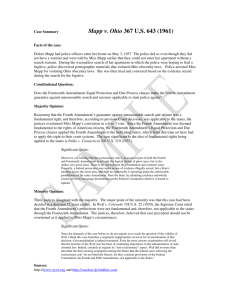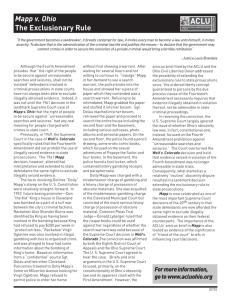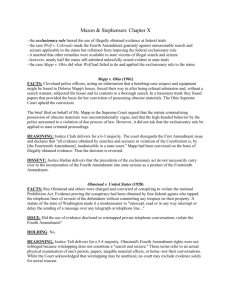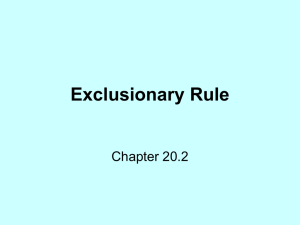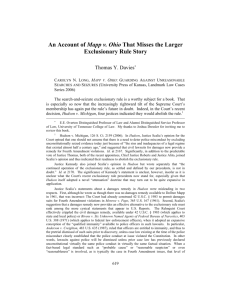CX Mapp-Rehmke
advertisement
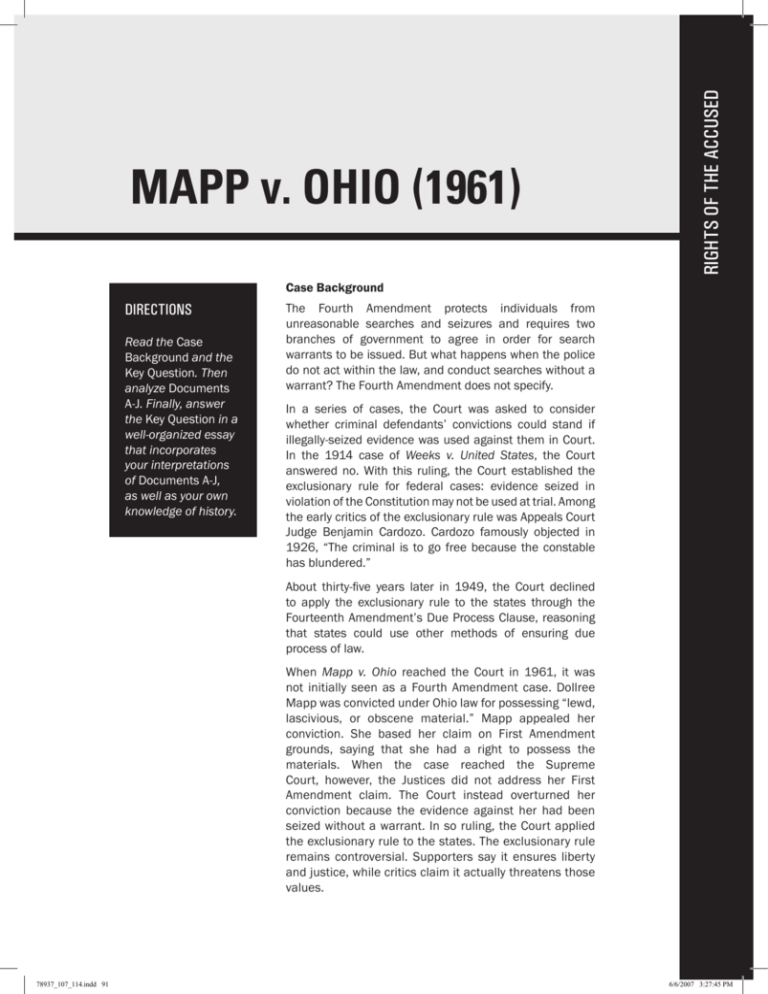
rights of the accused Mapp v. ohio (1961) Case Background directions Read the Case Background and the Key Question. Then analyze Documents A-J. Finally, answer the Key Question in a well-organized essay that incorporates your interpretations of Documents A-J, as well as your own knowledge of history. The Fourth Amendment protects individuals from unreasonable searches and seizures and requires two branches of government to agree in order for search warrants to be issued. But what happens when the police do not act within the law, and conduct searches without a warrant? The Fourth Amendment does not specify. In a series of cases, the Court was asked to consider whether criminal defendants’ convictions could stand if illegally-seized evidence was used against them in Court. In the 1914 case of Weeks v. United States, the Court answered no. With this ruling, the Court established the exclusionary rule for federal cases: evidence seized in violation of the Constitution may not be used at trial. Among the early critics of the exclusionary rule was Appeals Court Judge Benjamin Cardozo. Cardozo famously objected in 1926, “The criminal is to go free because the constable has blundered.” About thirty-five years later in 1949, the Court declined to apply the exclusionary rule to the states through the Fourteenth Amendment’s Due Process Clause, reasoning that states could use other methods of ensuring due process of law. When Mapp v. Ohio reached the Court in 1961, it was not initially seen as a Fourth Amendment case. Dollree Mapp was convicted under Ohio law for possessing “lewd, lascivious, or obscene material.” Mapp appealed her conviction. She based her claim on First Amendment grounds, saying that she had a right to possess the materials. When the case reached the Supreme Court, however, the Justices did not address her First Amendment claim. The Court instead overturned her conviction because the evidence against her had been seized without a warrant. In so ruling, the Court applied the exclusionary rule to the states. The exclusionary rule remains controversial. Supporters say it ensures liberty and justice, while critics claim it actually threatens those values. 78937_107_114.indd 91 6/6/2007 3:27:45 PM key Question Assess the claim that the exclusionary rule helps ensure liberty and justice. Documents you will examine: a b c d e f g h i j 78937_107_114.indd 92 James Otis, Against Writs of Assistance, 1761 The Fourth Amendment, 1791 Section of the Fifth Amendment, 1791 Section of the Fourteenth Amendment, 1868 Weeks v. United States, 1914 Wolf v. Colorado, 1949 Majority Opinion (6-3), Mapp v. Ohio, 1961 Concurring Opinion, Mapp v. Ohio, 1961 Dissenting Opinion, Mapp v. Ohio, 1961 “I Don’t Care That Your Conviction Was Overturned,” 2002 6/6/2007 3:27:45 PM document a James Otis, Against Writs of Assistance, 1761 Note: Writs of Assistance were general search warrants allowing British officials to search the Colonists’ homes and businesses when and where they pleased. I will to my dying day oppose, with all the powers and faculties God has given me, all such instruments of slavery on the one hand and villainy on the other as this Writ of Assistance is. It appears to me the worst instrument of arbitrary power, the most destructive of English liberty and the fundamental principles of law, that ever was found in an English law-book…. [General writs of assistance are] a power that places the liberty of every man in the hands of every petty officer. I say I admit that special Writs of Assistance, to search special places, may be granted to certain persons on oath; but I deny that the [general] writ now prayed for can be granted… What is the difference between general Writs of Assistance and “special Writs of Assistance”? document b The Fourth Amendment, 1791 What similarities do you see between the Fourth Amendment and Otis’s description of “special Writs of Assistance” in Document A? document c Section of The Fifth Amendment, 1791 No person shall be … compelled in any criminal case to be a witness against himself. mapp v. ohio List three ways a person might act as a “witness against himself.” ©the Bill of Rights Institute The right of the people to be secure in their persons, houses, papers, and effects, against unreasonable searches and seizures, shall not be violated, and no warrants shall issue, but upon probable cause, supported by oath or affirmation, and particularly describing the place to be searched, and the persons or things to be seized. 93 78937_107_114.indd 93 6/6/2007 3:27:45 PM document d Excerpt from the Fourteenth Amendment, 1868 No state shall … deprive any person of life, liberty, or property, without due process of law. Are the requirements of the Fourth and Fifth Amendments (Documents B and C) essential parts of “due process of law”? document e Weeks v. United States, 1914 Where letters and papers of the accused were taken from his premises by an official of the United States … without any search warrant and in violation of the constitutional rights of accused under the Fourth Amendment, and … they are used in evidence over his objections, prejudicial error is committed and the judgment [conviction] should be reversed. [The Fourth Amendment] took its origin in the determination of the framers of the Amendments to the Federal Constitution to provide for that instrument a Bill of Rights, securing to the American people … those safeguards … to protect the people from unreasonable searches and seizures, such as were permitted under the general warrants … and seizures under the so-called writs of assistance, issued in the American colonies. ©the Bill of Rights Institute Why did the Court rule that illegally seized evidence may not be used in federal criminal trials? document f Wolf v. Colorado, 1949 In Weeks v. United States, this Court held that in a federal prosecution the Fourth Amendment barred the use of evidence secured through an illegal search and seizure. This ruling was made for the first time in 1914. It was not derived from the explicit requirements of the Fourth Amendment.… mapp v. ohio The exclusion of evidence is a remedy which directly serves only to protect those upon whose person or premises something incriminating has been found. We cannot, therefore, regard it as a departure from basic standards to remand such persons … to the remedies of private action and such protection as the internal discipline of the police, under the eyes of an alert public opinion, may afford.… (continued on next page) 94 78937_107_114.indd 94 6/6/2007 3:27:45 PM We hold, therefore, that in a prosecution in a State court for a State crime the Fourteenth Amendment does not forbid the admission of evidence obtained by an unreasonable search and seizure. Why did the Court refuse to apply the exclusionary rule to the states? document g majority opinion Majority Opinion (6-3), Mapp v. Ohio, 1961 Since the Fourth Amendment’s right of privacy has been declared enforceable against the States through the Due Process Clause of the Fourteenth, it is enforceable against them by the same sanction of exclusion as is used against the Federal Government … in extending the substantive protections of due process to all constitutionally unreasonable searches—state or federal—it was logically and constitutionally necessary that the exclusion doctrine—an essential part of the right to privacy—be also insisted upon as an essential ingredient of the right.… [O]ur holding that the exclusionary rule is an essential part of both the Fourth and Fourteenth Amendments is not only the logical dictate of prior cases, but it also makes very good sense. There is no war between the Constitution and common sense. Our decision, founded on reason and truth, gives to the individual no more than that which the Constitution guarantees him, to the police officer no less than that to which honest law enforcement is entitled, and, to the courts, that judicial integrity so necessary in the true administration of justice. Why did the Court apply the exclusionary rule to the states? What did the Court mean by “judicial integrity”? mapp v. ohio Is the Court’s ruling the only way to protect citizens from unreasonable searches? Can you think of any alternatives to the exclusionary rule? ©the Bill of Rights Institute There are those who say … that under our constitutional exclusionary doctrine “[t]he criminal is to go free because the constable has blundered.” …[And] in some cases this will undoubtedly be the result. But…there is another consideration— the imperative of judicial integrity. …The criminal goes free, if he must, but it is the law that sets him free. Nothing can destroy a government more quickly than its failure to observe its own laws, or worse, its disregard of the charter of its own existence. 95 78937_107_114.indd 95 6/6/2007 3:27:45 PM document h Concurring Opinion, Mapp v. Ohio, 1961 I am still not persuaded that the Fourth Amendment, standing alone, would be enough to bar the introduction into evidence against an accused of papers and effects seized from him in violation of its commands. For the Fourth Amendment does not itself contain any provision expressly precluding the use of such evidence, and I am extremely doubtful that such a provision could properly be inferred from nothing more than the basic command against unreasonable searches and seizures. Reflection on the problem, however … has led me to conclude that when the Fourth Amendment’s ban against unreasonable searches and seizures is considered together with the Fifth Amendment’s ban against compelled selfincrimination, a constitutional basis emerges which not only justifies but actually requires the exclusionary rule. How does this opinion come to the same conclusion as the majority, yet for a different reason? document i Dissenting Opinion, Mapp v. Ohio, 1961 In this posture of things, I think it fair to say that five members of this Court have simply “reached out” to overrule Wolf…. ©the Bill of Rights Institute It seems to me that justice might well have been done in this case without overturning a decision on which the administration of criminal law in many of the States has long justifiably relied…. I would not impose upon the States this federal exclusionary remedy…. Our concern here is not with the desirability of that [exclusionary] rule but only with the question whether the States are Constitutionally free to follow it or not as they themselves determine…. Why are the dissenters concerned that the majority overruled Wolf (Document F)? mapp v. ohio 96 78937_107_114.indd 96 6/6/2007 3:27:45 PM document j “I Don’t Care That Your Conviction Was Overturned,” 2002 What is the cartoonist’s viewpoint about the exclusionary rule’s relationship to moral and legal justice? Assess the claim that the exclusionary rule helps ensure liberty and justice. mapp v. ohio Answer the Key Question in a wellorganized essay that incorporates your interpretations of Documents A-J, as well as your own knowledge of history. key Question ©the Bill of Rights Institute directions 97 78937_107_114.indd 97 6/6/2007 3:27:46 PM the endures Georgia v. Randolph, 2005 …It is fair to say that a caller standing at the door of shared premises would have no confidence that one occupant’s invitation was a sufficiently good reason to enter when a fellow tenant stood there saying, “stay out.” …There is no common understanding that one co-tenant generally has a right or authority to prevail over the express wishes of another, whether the issue is the color of the curtains or invitations to outsiders…. We therefore hold that a warrantless search of a shared dwelling for evidence over the express refusal of consent by a physically present resident cannot be justified as reasonable as to him on the basis of consent given to the police by another resident. ©the Bill of Rights Institute Why does the Court hold that police cannot search a home without a warrant when one resident consents to the search but the other does not? Do you agree with this ruling? Why or why not? mapp v. ohio 98 78937_107_114.indd 98 6/6/2007 3:27:46 PM

